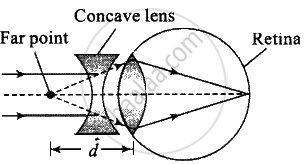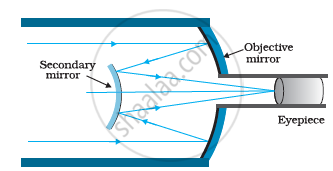Advertisements
Advertisements
प्रश्न
A myopic adult has a far point at 0.1 m. His power of accomodation is 4 diopters.
- What power lenses are required to see distant objects?
- What is his near point without glasses?
- What is his near point with glasses? (Take the image distance from the lens of the eye to the retina to be 2 cm.)
उत्तर
 (a) Defected eye |
 (b) Removal of Defect |
`1/f = 1/f_1 + 1/f_2`
In terms of power P = P1 + P2
i. If for the normal relaxed eye of an average person, the power at the far point be `P_f`. The required power
`P_f = 1/f = 1/0.1 + 1/0.2` = 60 D
By the corrective lens the object distance at the far point is `oo`
The power required is `P_f^' = 1/f^' = 1/(oo) + 1/0.02` = 50 D
Now for eye + lens system, we have the sum of the eye and that of the glasses `P_g`
`P_f^' = P_f + P_g` ⇒ 50 D = 60 D + `P_g`
Which gives, `P_g` = – 10 D
ii. For the normal eye his power of accommodation is 4 D, Let the power of the normal eye for near vision be `P_n`.
Then, 4 = `P_n = P_f` or `P_n` = 64 D
Let his near point be `x_n`, then
`1/x_n + 1/0.02` = 64 to `1/x_n + 50` = 64
`1/x_n` = 14 ⇒ `x_n = 1/14 m` = 0.07 m
iii. With glasses `P_n^' = P_f^' + 4` = 54
54 = `1/x_n^' + 1/0.02 = 1/x_n^' + 50`
`1/x_n` = 14 ⇒ `x_n^' = 1/4 m` = 0.25 m
APPEARS IN
संबंधित प्रश्न
Does short-sightedness (myopia) or long-sightedness (hypermetropia) imply necessarily that the eye has partially lost its ability of accommodation? If not, what might cause these defects of vision?
A person looking at a person wearing a shirt with a pattern comprising vertical and horizontal lines is able to see the vertical lines more distinctly than the horizontal ones. What is this defect due to? How is such a defect of vision corrected?
What should be the distance between the object and the magnifying glass if the virtual image of each square in the figure is to have an area of 6.25 mm2. Would you be able to see the squares distinctly with your eyes very close to the magnifier?
A Cassegrain telescope uses two mirrors as shown in the figure. Such a telescope is built with the mirrors 20 mm apart. If the radius of curvature of the large mirror is 220 mm and the small mirror is 140 mm, where will the final image of an object at infinity be?

The muscles of a normal eye are least strained when the eye is focussed on an object
When objects at different distances are seen by the eye, which of the following remain constant?
The focal length of a normal eye-lens is about
The distance of the eye-lens from the retina is x. For a normal eye, the maximum focal length of the eye-lens
A man wearing glasses of focal length +1 m cannot clearly see beyond 1 m
A person looks at different trees in an open space with the following details. Arrange the trees in decreasing order of their apparent sizes.
| Tree | Height(m) | Distance from the eye(m) |
| A | 2.0 | 50 |
| B | 2.5 | 80 |
| C | 1.8 | 70 |
| D | 2.8 | 100 |
